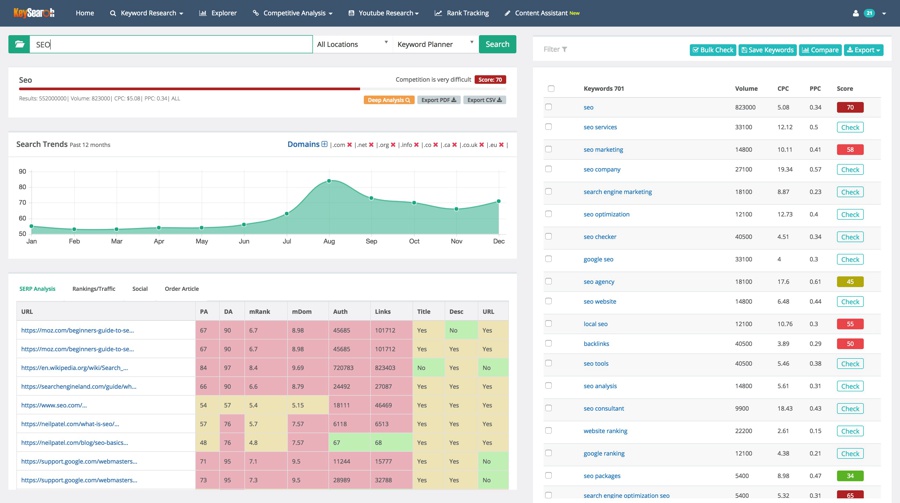In 2018 we were able to nearly triple the traffic to this website and more than double our income using simple but effective SEO. This has had an enormous impact on our business, how far we can spread our message, and (thanks to the added cash in the bank) our lifestyle.
But SEO didn’t always come easy to us. We have been blogging since 2012 and in the time between 2012 – 2018 we managed to grow our blog to around 100,000 users per month, which we were very happy about.
In 2018 we boosted that up to over 280,000 and today the traffic is over 350,000 users per month and growing, making it one of the most trafficked travel blogs online!
So how did we do it? What did we learn after 6 years of blogging that had such a massive impact?
Simple. SEO.
In November of 2017 we hired an SEO Specialist Team out of the UK and they did a complete audit of our website. What came back was shocking! Much of the work that we had put into our website was actually hindering our progress, rather than helping us grow traffic.
We were instantly humbled and a bit embarrassed.

How could we have possibly missed all of this even though we’d been working on our SEO for years?
The answer is that, while there’s A TON of information online these days about how to get traffic to your website using SEO, much of it is conflicting and some of it is just flat-out wrong.
We were like so many other bloggers and webmasters out there. We were Googling everything and trying to piece together all of that information on our own and it simply wasn’t working.
In this post, I want to help shine some light on the subject of SEO so that if you have a blog, website or online business, you can easily and quickly grow your traffic.
What You’ll Learn:
- What is SEO
- How To Get Traffic Using SEO
- House Keeping: Cleaning Up The Backend Of Your Website
- How To Optimize Your Site Load Speed
- The Importance of SSL
- How To Do Keyword Research (The Right Way)
- How To Write Posts That Will Rank On Page 1 of Google
- How To Market Your Content To Drive Traffic & Help SEO
- How To Interlink
- How To Learn How To Do All Of This in Video Training
Let’s get started.
What is SEO?
Let’s start with the really simple terms here. SEO stands for Search Engine Optimization. But what it really means is Google Optimization, because Google currently claims over 81% of all search engine traffic on the web, it’s responsible for 2 trillion searches per year and its bots crawl 130 trillion web pages around the world.
Yes. Google is boss.
So, while other search engines do drive some traffic and they’re not completely irrelevant, when marketers, webmasters, bloggers and SEO gurus talk about SEO, they’re talking about Google.
SEO is the practice of optimizing your website’s code, authority and individual pieces of content (posts and pages) in order to drive more traffic from Google.
How To Get Traffic To Your Website With SEO
This is something all bloggers struggle with. When we were first starting out with this blog, we would check the traffic every day and we would see that hardly anyone was visiting our site. It took us years before we had an audience and years more before we had a real impact in our space.
That’s because we didn’t properly utilize SEO.
We were Googling everything we could and it took us a long time to figure it all out. But what really helped us was hiring the expert SEO team.
They really distilled down all of the garbage information we had floating around in our heads from years of ineffective research and implementation, and gave us a concrete, actionable and impactful plan for our SEO.
Housekeeping
When our SEO team first went over our site, they gave us a massive list of things we needed to fix in the backend of the site and with the content that was already up. The list was so huge that at first we thought that we had been doing everything wrong for all of these years! But the team assured us that every single site they do this audit for has a similar sized list of errors.
They gave us so much to fix that I’m not going to list it all in this post, but here are the things that I think had the biggest impact:
Thin Content
When we first started out, we didn’t know what we were doing, so we created some pages that just had buttons on them, some posts were only 300 words long and some were just plain terrible and not useful. Google penalizes sites for having too much “thin content”, so our team gave us the tools needed to find and fix all of this content.
Broken Links
Broken links on a site are bad for user experience and thus, bad for SEO. Luckily for WordPress blogs they’re pretty easy to find and fix. The Broken Link Checker makes the process pretty easy, I just recommend actually viewing the page where the broken link is found to make sure it’s actually broken. In our experience, sometimes it’s not.
Orphan Pages
These are pages that stand alone on a site with no links going in or out. They’re not all that easy to find, but they hurt your Google rankings for sure. By finding these pages on your site and deleting them, you’ll show Google that your blog is one big cohesive web of great content.
XML Sitemap
These help Google (and your readers) to see every post and page on your website. A properly set-up sitemap will help bots to more easily crawl your website. Luckily there are plugins to set these up. We’ve used Simple Sitemap in the past and it worked well, you just have to make sure you go into Google Search Console afterwards and verify it.
Optimize Site Speed
This is a big one. Starting in July of 2018, Google launched an algorithm update that changed the way it indexes the web. Knowing that users of the internet have an extremely short attention span, Google started ranking sites based on their loading speed. Simply put, if your site loads slow these days, you won’t get as much traffic from Google.
Site speed has always affected traffic. If people have to wait more than a couple of seconds for each of your pages to load, they’ll leave your site. But now Google has actually started removing websites from search results for having slow load times. You need to speed up your site. But how?
Optimize & Resize Images
The biggest drag on your speed (particularly for visual sites like travel blogs) is image size. You need to do two things to every image in your media library. You need to resize it AND compress it.
Resizing Images: To bulk resize all of the images in your library, you can download the Imsamnity Plugin for WordPress. This plugin will allow you to resize every image currently in your library. Every theme is different, but for main images within posts, usually 900px wide is a good size, while some themes have larger images in the header or for featured images (like ours). For these, 1600px wide is a good number.
Optimizing Images: Now that your images are resized, you need to optimize them. Basically, resizing is changing the physical size of the image in pixels, while optimizing is stripping the coding and data from the image to make the file size smaller, thus helping it load faster on your site. Smush Image Compression Plugin is the one that most bloggers use. When done correctly, you can compress an image by as much as 50% without losing any quality.
Cache Your Site
Caching allows your users’ browsers to store parts of your website so that your server doesn’t have to do all of the work and the pages will load faster. One of the best, free plugins for WordPress is W3 Total Cache. Once installed and set up correctly, this plugin can have a massive impact on your site’s load speed.
CDN (Content Delivery Network)
CDN or Content Delivery Network, is basically a network that allows your site to load from a server that is to the visitor who is accessing it. Some hosts (including our favourite, Bluehost), have built in CDNs, but I recommend hooking up CloudFlare to your website. They have a free version and you can upgrade later at any time.
By setting up W3 Total Cache and CDN using all of the proper settings (there are many), I was able to boost one of my new website’s speed by 300%. Yes, it works like a charm, it will help your site load faster and it will help you get more traffic.
Get SSL Certified
There are many reasons to get an SSL certificate for your site. It will allow you to take secure credit card payments down the road, it gives your site trust and authority, and it will help your SEO. When your site is SSL certified, it will have an https:// in the url rather than https://.
This tells the browsers, users and Google that your site is safe and can process and store data in a secure way. Ever since 2014, SSL has been identified as a ranking signal for Google, meaning that if you don’t have it, you’re missing out on potential traffic.
To get SSL certified, the best way is to contact your host and ask them for your help. Bluehost makes it really simple with a free switch in the cPanel that only takes a second to turn on, but every host is different.
Contact your host and ask them to turn on SSL for your domain and redirect your existing site to the new https:// address.
Do Effective Keyword Research
This may be one of the biggest factors for our SEO success in 2018. We had never invested any money in a proper keyword research tool. I’ve tried so many different free ones and up until the end of 2017 I assumed I was getting all of the data I needed. Man, was I wrong.
Free SEO tools typically use different data that the paid ones. But some of the paid ones are EXTREMELY expensive. Ahrefs for example, takes their keyword data from Clickstream and it is very accurate, but its prices start at $99 / month.
KeySearch takes data directly from Google, but it organizes it in a way that even a beginner user can draw valuable data at first glance.
KeySearch is the tool we use and it’s basically changed the way we think about our keywords. At first we were overwhelmed by all of the different tabs, screens and features of the tool, but over time we’ve mastered every single thing that this tool can do.

From basic keyword research and difficulty checks to page analyzing and SERP word count, this program gives you all the data you need to rank page 1 on Google. I’m not sponsored by KeySearch by the way. I know that’s typically implied these days when a blogger speaks this highly of a product. I just love it.
I have been recommending it to all of my students in my courses for months now. I do have an affiliate link for them however. If you Click Here and use the coupon code “GOAT20” at checkout, you’ll get 20% off the price of this tool. I get a small kickback, so I appreciate your support, but really I recommend it because it’s amazingly useful.
They key with KeySearch (pun intended) is to find keywords that have high search volume and low competition. A lot of people use the free Google Keyword Planner as their keyword research tool (I did in the past as well). While this data is accurate, it doesn’t give you enough of it! Keyword Planner has a “Difficulty” number, but this is commonly mistaken as difficulty to rank, when actually it only pertains to the cost of ads against the term.
KeySearch’s difficulty ranking is very accurate. It gathers information from websites on the first page of Google like their Domain Authority (DA), Page Authority (PA), backlinks, internal links, keyword placements, word count and so much more and gives you an easy to visualize, color-coded number between 1-100 to tell you how difficult it will be to rank for the chosen keyword.
When utilizing the keyword research data properly, and all of the other tools in KeySearch together, you can explode your traffic quickly by writing new posts that will actually rank page 1 in Google. We got so good at maximizing KeySearch data for our SEO content writing that we’ve been able to rank page 1 for relatively difficult terms just weeks after hitting publish.
Above is a screenshot of our analytics for one article we published on September 30th 2018. The initial spike is from our newsletter, social media and regular followers. The second spike is just over 2 weeks after the post was published when it went to page one in Google and started bringing in as much as 700 page views per day.
That is the power of proper keyword research and the potential power of KeySearch done right.
💡Pro Tip: Even though KeySearch is technically a keyword research tool, there’s even more data found on other tabs within this tool. Make sure you utilize Explorer, Rank Tracking and Content Assistant within the tool as well.
Writing Better Content
We, like every other WordPress blogger, use the amazing free tool Yoast, to help us write great SEO content on our blog. We’ve been using this tool for years and it’s always helped us to ensure that there are enough keywords in our articles, alternative texts, meta description, slugs and that the readability of our posts was good.
But there’s a lot more to on page SEO than this!
It’s all about honing in on what actually ranks in Google and by pairing the data we draw from KeySearch (like SERPs, word count, & page analyzers) with the indicators from Yoast and then testing out what actually works in search results, we’ve been able to write better, more useful content all while getting on page one in Google.

This is why present SEO is so amazing. It’s making the web a better place. Proper SEO means that you’re writing the most useful content you possibly can all of the time. This helps our readers get the answers they’re looking for, and it helps us get more traffic. It’s a win-win.
💡 Pro Tip: These days just using Yoast and a keyword research tool isn’t enough. You have to take the data from the keyword research tool and use it when writing your SEO content, then use Yoast and A/B test what works in search results.
Market Your Content Like Crazy
This is something we’ve always been good at. Back in 2014 before a massive trip we did in Central Asia, we did a marketing explosion on the web. I’ve covered this strategy a lot on this blog, and it’s something that I think EVERY website, particularly new ones, need to do this on a regular basis.
So how do you market like a master?
Social Media
This is the long-standing king of online marketing. When you publish a new post, you need to give it wings on social media. But just posting a link doesn’t always work. Facebook’s algorithms will automatically diminish your reach if you have a link in your posts. They want photos. Instagram doesn’t let you reach a lot of people if you don’t get a lot of likes and comments right off the bat, and Pinterest takes real mastery.
The number one social media platform for driving traffic tot a website is Pinterest for sure. So it’s important that you create a Pinterest image for every post you write on your blog.
We (and pretty much everyone to ever use Pinterest) use the free online tool Canva to create beautiful Pinterest designs for our blog posts. We then spend a lot of time getting added on to influential group boards and we pin all of those beautiful images to as many boards as possible. Tools like Tailwind can help massively with scheduling of Pinterest posts and organization. (Creating pretty Pinterest images is great job for virtual assistants).
Read More:
For Facebook, we always engage with our readers in a different way. It’s important to keep a “healthy page” in Facebook. To do this you need to vary the way you interact with your followers. Sometimes you do a video, sometimes a photo, sometimes a live video, sometimes a fill in the blank, sometimes a long post. The more you vary it, the better reach you get when you finally do add a link.
Instagram is all about photos. The better your photo, the more reach you’ll get. So having a sexy photo for your blog post to share on Instagram is imperative. Then you can add a link to your blog in the Author’s bio.
Lastly is Twitter. Twitter is pretty easy, but it won’t likely drive you a whole lot of traffic. Basically every time you write a post on your blog, you should set up a tweet schedule for it over the coming days / weeks using an online tool like Hootsuite.
Guest Posting & Backlinking
Backlinking has long been one of the best ways to boost your traffic with SEO, but it’s easy to get penalized for not doing it right! I am still a firm believer that guest posting is the most ethical and effective way of building backlinks to your site.
You write awesome, useful content for other websites and from that content you link back to your site. Simple as that. But just writing the content isn’t the most important part. You need to make sure you build a healthy, varied anchor text profile back to your site, meaning you link back using a variation of the key term you’re trying to write for.

Also, it’s much more effective to do periodic “guest post bombs”. This is when you write 15 – 25 unique (and super awesome) guest posts for 15 – 25 different websites and ask each of them to publish within the same week.
I’ve talked about why this strategy is so effective in my Guide To Guest Posting, but basically people will all of a sudden see your site EVERYWHERE, and that will help your social proof. Also, the backlinks will help your site authority and your rankings in Google.
Getting Featured
While guest posts can drive a bit of traffic to your site, nothing can give you that massive spike in traffic like a feature on a massive website like Forbes, Lonely Planet, Business Insider and National Geographic. To get these types of features, you have to reach out and pitch your unique story to these big brands and hope you can get a post on their website’s with a link back to your blog.
A link back form a high DA site like Forbes will not only send you a TON of traffic, it will also massively help your site’s own DA and rankings in Google over time. Google will see a link from Forbes and think: “OK, if Forbes links to this blog, it must be reputable.”
Interlinking
Interlinking is when you link one of your blog posts, to another blog post on your own site. I think this was one of the main things we were missing when we were working on our SEO in the past. We just figured that Google ranks backlinks more than internal links so we’d focus more on that. This was a mistake.
If you want to increase your traffic, your authority and your rankings in Google, then you have to show Google that you’re an expert on each topic on your site. For travel blogs, this typically means being an expert on each destination you write about. For food blogs it might be an expert on each type of cuisine and technique, and with a tech blog it may mean being an expert on each category of technology.
Basically you have to write a lot of great articles on each topic and link them all to each other. In 2018 we went back on all of our older posts and added more value to them, and also interlinked them all to each other. This not only helps Google’s bots crawl our site easier, but it also helps the user experience for our readers (which is also another ranking factor in Google).
If someone is interested in a topic on our blog, they can now easily click over to another post on that topic to learn more about it. We’re creating better content for our readers, and interlinking it in a way that shows Google it’s a “content cluster” or “pillar web”. This helps to tell the search engines that we’re an authority on the topics we write about.
Interlinking is as valuable in 2019 if not more valuable than backlinking, guest posting and off-page SEO. A well-laid-out internal link web can work wonders for both user experience, and Google traffic.
💡 Pro Tip: You should go back into all of your current posts and make sure to add as many internal links to other relevant posts as possible and when you write a new post on your blog, you should go into all relevant posts and link to it.
Want Help Getting More Traffic To Your Website?
To summarize, it took us a lot of years to finally master our SEO and I think we’ve finally got to a place where we can honestly say we know how to rank page 1 in Google for pretty much any key term.
But it wasn’t easy and it wasn’t cheap. Huge SEO companies charge big money (think $700+ per month) to help with SEO and actually grow your traffic quickly. But you don’t need to spend that kind of money in order to succeed.
I was so happy with our success in 2018 that I really want to share what I’ve learned with other bloggers, website owners and online entrepreneurs (that’s you!).
That’s why I created a 1-Hour SEO Video Training Session to go over the most valuable aspects of SEO with you, for FREE.
In the session, we’ll cover:
- How to do effective keyword research (ie: how to find high-volume keywords that your blog can actually rank for).
- How to write better SEO content that Google and your readers will love.
- How to properly interlink your blog posts to create a “pillar web” that Google bots will send traffic to
- How to market your new content, build valuable backlinks and explode your traffic quickly
- + Much more
I’m sure you’ll love it! Click Here to get free access now. I look forward to having you email me with screenshots of your analytics to see just how much the SEO Training Session helped explode your blog traffic. I know that you can triple your traffic in a year using these strategies — that’s how effective they are.
Click here for instant access to free seo training
What is your biggest struggle with SEO? Have you mastered traffic growth for your blog? Leave a comment below and I’ll help you out.
Lead image courtesy of Shutterstock.com.
Like This Article? Pin it!


















